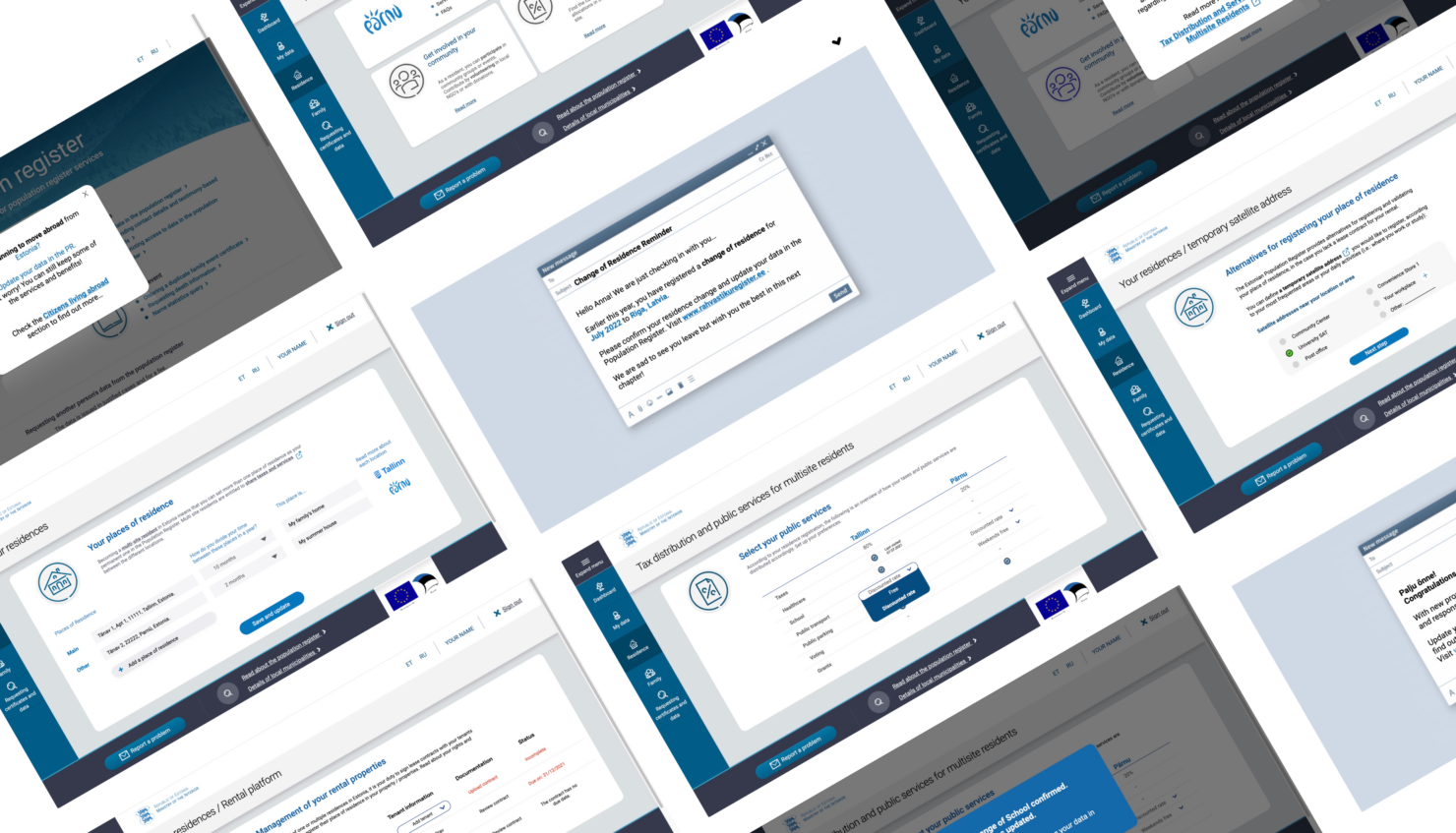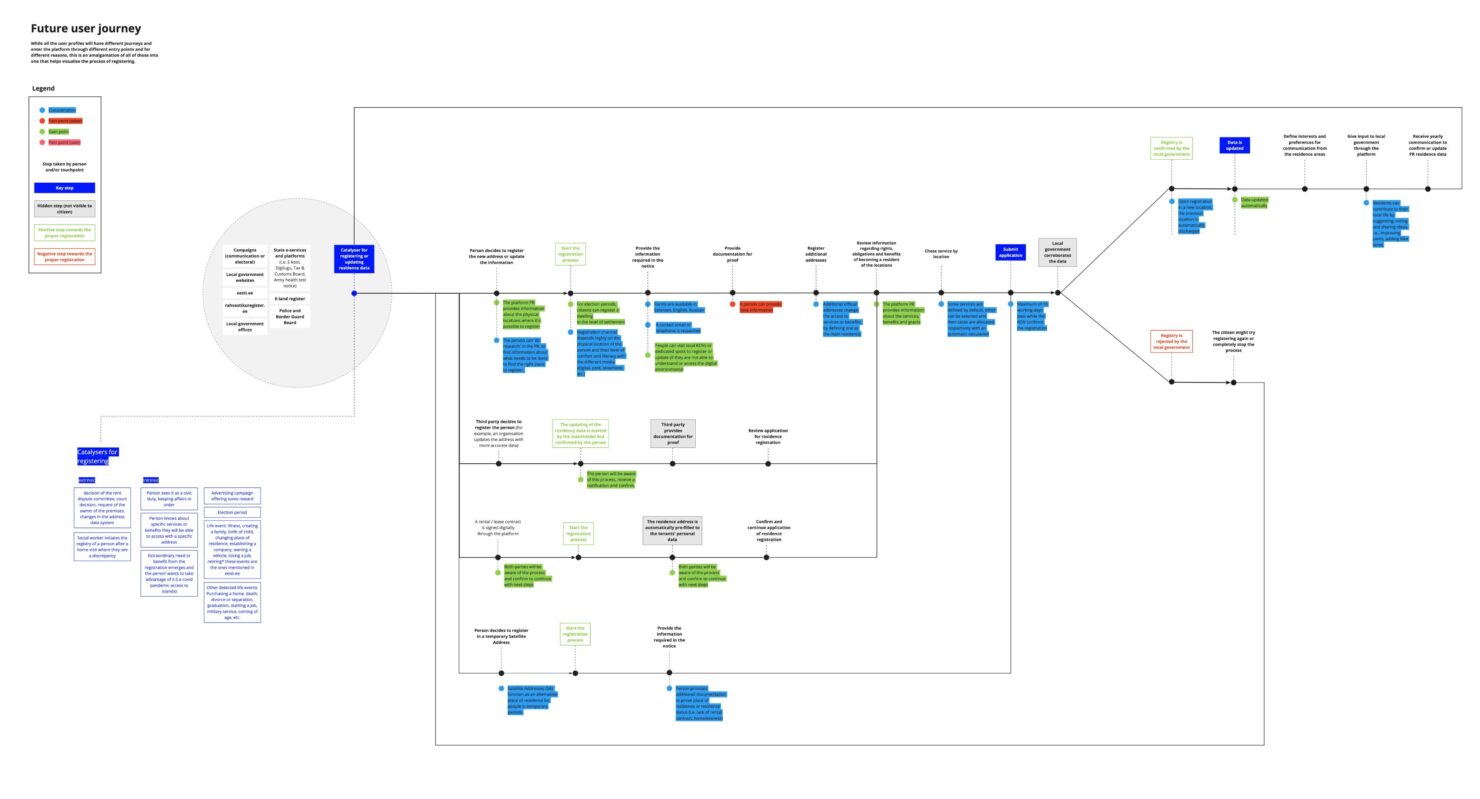2022 | StrategicService DesignUser Research
RITA Mobile Life – Improving the accuracy of residence data in Estonia
How a user-centred approach helps resolve a long-standing issue about the Estonian Population’s Registry data and reduce the distance between the state and the population.

30% of the Estonian residents have incorrect data in the Population Register.
This means that currently, the state does not have a clear and thorough overview of the actual places of residence of its population and thus cannot accurately allocate resources and plan for the public services that people need (e.g schools, kindergartens, medical services, social benefits, among others). Additionally, the state is unable to contact the people when necessary as the mobility of population has increased and it is possible to register one official residency in the Population Register*. Still today the information exchange is largely via regular mail, which is burdensome for both sides and is not in line with the development of digital state and digital skills of the population.
*Spoiler alert: now you can add additional addresses in the Population Registry. So the research has already made some impact!
How to close this lingering gap between the residents and the state?
Under the project created by the University of Tartu we worked to find workable solutions to improve the accuracy of people’s residence data in the Estonian Population Register but also the electronic exchange of information between the state and citizens through a service design perspective. Our work had to take into account people’s lifestyles, their mobility, the digital age and the state’s ability to administer the solution.
But first, is the Population Register really a service?
We think it is! The Population Register is not only a database, as it also has physical and digital infrastructure, processes, specific touchpoints and users, which all facilitate and enable information exchange between the state and the resident. As services are defined as the delivery of intangible value commonly from an organisation to a person, the Population Register can be considered as such when residents provide accurate, truthful and valuable information and in return the state gives the opportunity to participate in the political life, enable political decisions and use public services.
The co-design process
Our task was to develop the solutions for the target groups with the biggest discrepancy between the registered and actual places of residency by taking into consideration their views and attitudes. We took on a human-centred perspective and worked to consider people holistically with their complexities and different lifestyles. To do so, different methods and tools came in handy: desktop research, material analysis, co-design sessions, personas creation. Co-designing also meant that the design concepts and proposal were created for and with users, through workshops. These concepts were also validated with the target users in focus groups and through an online questionnaire.

Feeling of home, lack of awareness and need for value
During our work, we found some interesting insights, which later proved to be the key for the design process:
- Users are not aware of the Population Register and that updating their residency information is mandatory – the entry points to the platform are not uniformly understood / known by Estonian residents. It is clear that there are several points of contact and retrieval methods to direct users to register their data, including campaigns, local government websites, the eesti.ee portal, etc. However, users will not become aware of these points of contact until there is a catalyst that requires the location data to be updated.
“Firstly, this topic should be covered more somehow. I even don’t know if I’ve ever used the register. I’ve never thought that there could be something useful for me“
Survey respondent
- Some residents see no practical value in registering or updating their data in the Population Register– even though the current registration experience seems to be simple in terms of interactions, data needed and interfaces, the context and the uses of the residence address that people register create a strong pull not to provide accurate data and in many cases, it is because no practical value is perceived.
- The reasons why residents provide inaccurate data are often unintentional. Even though some residents clearly understand the services and benefits that can be obtained because of their residence registration, other users are less aware, less skilled or just haven’t updated or changed their data for a long time.
- The feeling of home is different for everybody and the current system is too rigid and traditional – we saw in several groups of users, particularly the most mobile ones, that the concept of home is not that of a fixed residency, but several places (where one comes from or even an owned property). While society has changed, the system has remained mostly traditional, with a clear and set definition of home address, and not many options for different lifestyles.
The concept for the platform
The resulting concept includes new features that would increase the practical and emotional value of the platform for different target groups, taking into account their lifestyles, preferences and complexities.
As far as the platform’s capabilities are concerned, the concept proposes new ways of communicating and, taking into account a number of specific target groups, offers new value-creating solutions such as:
- Possibility to register multiple residences as official
- Choice of tax placement
- Rental platform for tenants and landlords
- 3 different modes to validate a residence
- Information on rights, obligations and active citizenship
- Compatibility with other national platforms

On top of the concept, we also created a range of service recommendations for the platform and evaluated the impact of the proposal, the needed changes in regulations and larger implications of the features included in the concept.
The final report delivered is part of the RITA Mobile Life research project, which gives valuable input for the development plan for a coherent Estonia 2021-2030 led by the Estonian Ministry of the Interior and the Estonian Ministry of Culture.
And finally, some food for thought, a vision that we share for the future Population Register:
“The Population Register database is still for me a peculiar and distant platform, which I don’t associate with my everyday life. The functions that have been listed before are even somehow strange to imagine, because what has not existed before, can’t be longed for. It would be great to see in the future the Population Register as an inclusive and a transparent tool“
quote from a survey participant
Team
- Sofía Vega Anza – Design Lead
- Carolina Maia Groisman – Service Designer
- Nele Volbrück – Project Lead
Partners
- Kai Raku, Aivi Kullama – Worskshop Facilitators
- Miltton, Liisa-Indra Pajuste, Mari-Liis Kitter – Communications Partner
- Tartu Ülikool – Client